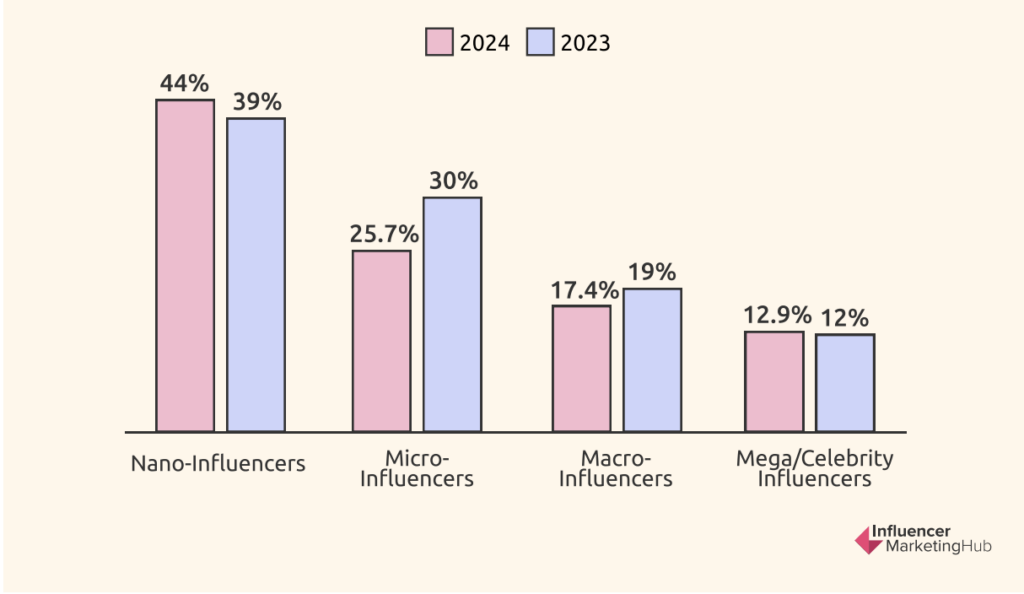Exploring the World of Influencers: Types and Their Effectiveness
Gone are the days when a catchy jingle or a celebrity endorsement was all you needed to capture consumers’ attention. Today’s savvy audience craves authenticity and trust. That’s where influencer marketing steps in.
Influencer marketing has exploded into a cornerstone of modern advertising strategies. Over 75% of marketers are now harnessing the power of influencers to elevate their brand message and connect with their target audience in a more meaningful way. Influencers are social media personalities, bloggers, YouTubers, or industry experts who have built a loyal and engaged following. Their audience trusts their recommendations and opinions. By partnering with influencers who align with your brand values and target demographic.
Influencers Categories
When Marketing Hub asked its audience about the likelihood of what kind of influencers they would work with (in terms of number of followers), they got data that 44% of brands chose to work with nano influencers, 25.7% chose micro-influencers, some large brands, 17.4% chose macro_influencers, and the remaining 12.9% chose to work with mega-influencers (celebrities).
Influencer Preference

Types of Influencers
1. Nano Influencers
Nano influencers have a relatively small following, usually ranging from 500 to 10,000 followers. Despite their smaller audience, they often have the highest engagement rates, making them highly effective for niche markets and localized campaigns
2. Micro Influencers
Micro influencers typically have between 10,000 and 100,000 followers . They are known for their high engagement rates and strong connections with their audience, making them ideal for brands looking to build trust and authenticity
3. Mid-Tier Influencers
Mid-tier influencers have follower counts ranging from 50,000 to 500,000. They offer a balance between reach and engagement, providing brands with a wide audience while maintaining a personal connection with their followers
4. Macro Influencers
Macro influencers boast followings between 100,000 and several million. They are often celebrities, TV personalities, or thought leaders, providing brands with extensive reach and significant visibility
5. Mega Influencers
Mega influencers, or celebrity influencers, have followings exceeding one million . They are highly visible on social media and can drive massive awareness for brands, though they come with higher costs and sometimes lower engagement rates compared to smaller influencers
6. Virtual Influencers
A new breed of influencers, virtual influencers, are computer-generated characters that have gained popularity on social media. They offer brands a unique way to engage audiences with creative and controlled content.
Effectiveness of Influencer Marketing
Influencer marketing goes beyond just slapping a logo on a billboard. It’s about creating compelling content that resonates with your target audience and fosters a genuine connection with your brand. By partnering with influencers who align with your brand values and to your target audience, you can increase their credibility and reach:
1. Engagement and Trust
Influencers, especially those with smaller followings, tend to have higher engagement rates and stronger connections with their audience. This trust translates into more effective marketing campaigns, as followers are more likely to act on recommendations from influencers they trust.
2. Cost-Effectiveness
Influencer marketing can be more cost-effective than traditional advertising methods. For every $1 invested in influencer marketing, brands can expect an average return of $6.50. This high ROI makes influencer marketing an attractive option for businesses of all sizes.
3. Targeted Marketing
By collaborating with influencers who cater to specific niches, brands can ensure their message reaches the right audience. This targeted approach increases the likelihood of conversions and enhances the overall effectiveness of marketing campaigns.
4. Authentic Content
Influencers create content that resonates with their audience, resulting in more genuine and relatable brand promotion. Empowering influencers to craft authentic content that integrates seamlessly with their brand can lead to deeper audience engagement.
5. Challenges and Considerations
While influencer marketing offers numerous benefits, it also comes with challenges. The cost of partnering with mega influencers can be prohibitive for smaller brands. Additionally, brands have limited control over the content created by influencers, which can pose risks . The saturated influencer market also makes it difficult for brands to stand out
Conclusion
Influencer marketing is a dynamic and evolving field that offers brands unique opportunities to connect with their target audiences. By understanding the different types of influencers and their effectiveness, brands can craft strategic campaigns that maximize engagement and ROI. Whether leveraging the high engagement rates of nano influencers or the extensive reach of mega influencers, the key to success lies in building authentic and mutually beneficial relationships with influencers



